Is Sushi Healthy for You To Eat?
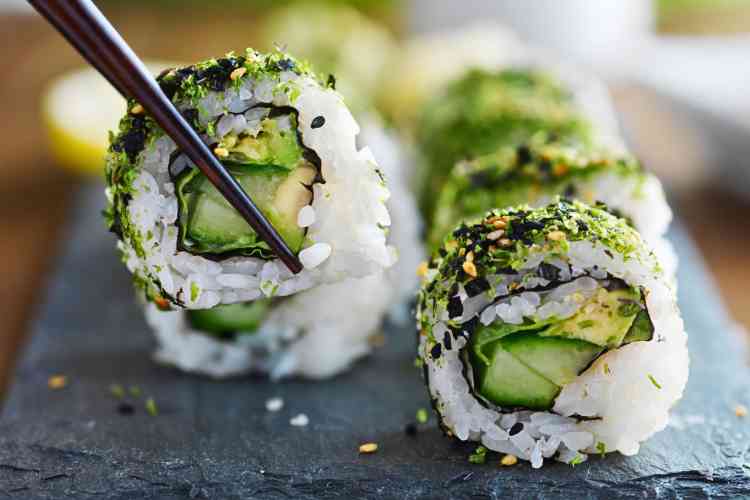
Few foods spark as much debate as sushi. On one hand, it’s elegant, fresh and brimming with ingredients that sound like they belong in a health magazine. On the other, it’s a minefield of hidden calories, creamy sauces and deep-fried surprises that can derail your goals.
So, is sushi healthy? The answer isn’t as simple as it seems.
For those who see sushi as a wholesome and healthy option, the truth might come as a surprise. While some kinds deliver lean protein and healthy fats, others pack extra calories and unexpected ingredients that might not align with your health goals. The good news is that if you’re mindful of your choices, the answer to “Is sushi healthy?” can tilt in your favor.
To help you discover exactly how healthy (or unhealthy) this popular Japanese food is, we've put together an in-depth guide on the nutritional benefits and drawbacks of sushi. You'll also find out which are the best kinds to enjoy and which types of sushi should be eaten as a treat, helping you to make smarter sushi choices.
Jump to Section
- Is Sushi a Healthy Food?
- How Healthy Is Sushi for You?
- What Are the Health Benefits of Sushi?
- What Is the Healthiest Sushi?
- What Is the Unhealthiest Sushi?
Is Sushi a Healthy Food?
You may be wondering: “Is sushi a healthy food?” The answer depends on what’s on your plate. Sushi can absolutely be part of a balanced diet, thanks to its mix of lean protein, healthy fats and complex carbohydrates. Ingredients like fresh fish provide omega-3 fatty acids that promote heart and brain health, while nori, the seaweed used in many rolls, adds antioxidants and essential vitamins.
Simple rolls with fresh and healthy vegetables, lean fish or whole-grain rice can provide a satisfying and nourishing meal. Toppings like tobiko can enhance flavor and offer a dose of protein and essential nutrients without piling on unnecessary calories. For those wondering: “Is sushi healthy?”, it often comes down to making smart ingredient choices.
However, not all sushi is created equal. When you get rolls loaded with fried tempura or creamy or sugary sauces, it’s fair to wonder: “Is sushi healthy for you?” These indulgent options may taste incredible, but they can be packed with hidden calories, unhealthy fats and high sodium levels that tip the scale away from a balanced meal.

Is Sushi Healthy for Weight Loss?
So, you may be wondering: “Is sushi healthy for weight loss?” Yes, it can be! But, that depends on the type you choose. While sushi can fit into a weight-loss-friendly meal plan, you’ll need to choose simpler, lower-calorie options and avoid rolls loaded with heavy sauces, fried ingredients and calorie-dense extras like cream cheese or spicy mayonnaise.
For the best results, stick to options like nigiri, one of the healthiest types of sushi. Sashimi is another excellent option for those wondering if sushi is healthy while trying to lose weight. Its simplicity ensures fewer calories without compromising on flavor or nutritional value.
Remember, weight loss ultimately boils down to maintaining a calorie deficit. Even when the answer to the question: “Is sushi healthy?” is yes, this type of food is best enjoyed when paired with a balanced diet and regular exercise.

How Healthy Is Sushi for You?
Sushi offers a variety of ingredients that can provide nutritional benefits when chosen wisely. Let’s break down the key components of sushi and the food’s impact on your health to fully answer the question: “Is sushi healthy?”
-
Fish: A rich source of protein and omega-3 fatty acids, fish like salmon, tuna and mackerel support heart and brain health. However, be mindful of mercury content in certain fish like tuna.
-
Rice: Is sushi healthy even with rice? White rice is common in sushi but has a high glycemic index and often, added sugar. Brown rice is a more nutritious option, offering more fiber to keep you fuller longer.
-
Vegetables: Ingredients like avocado, cucumber and carrots provide vitamins, minerals and fiber. Avocado, in particular, delivers heart-healthy fats.
-
Nori: This seaweed wrap is packed with vitamins A, C and E, plus iodine and antioxidants, making it a nutrient-dense component of sushi.
-
Sauces and Toppings: Creamy sauces like spicy mayonnaise and sugary glazes, such as teriyaki sauce, can add unnecessary calories and fats, which can lead to questioning if sushi is healthy when these toppings are overused. Additionally, soy sauce, while flavorful, is high in sodium, so it’s best to use it sparingly.
Sushi can be a satisfying and nutritional choice with the ultimate answer to whether sushi is healthy or not depending on the ingredients you choose and how the sushi is prepared.

What Are the Health Benefits of Sushi?
Sushi isn’t just a delicious meal. The ingredients are loaded with healthy nutrients to give your body the support it needs. From heart-healthy omega-3s to gut-friendly fiber, sushi can be highly nutritious. So, is sushi healthy? Let’s explore the specific ways sushi can boost your health.
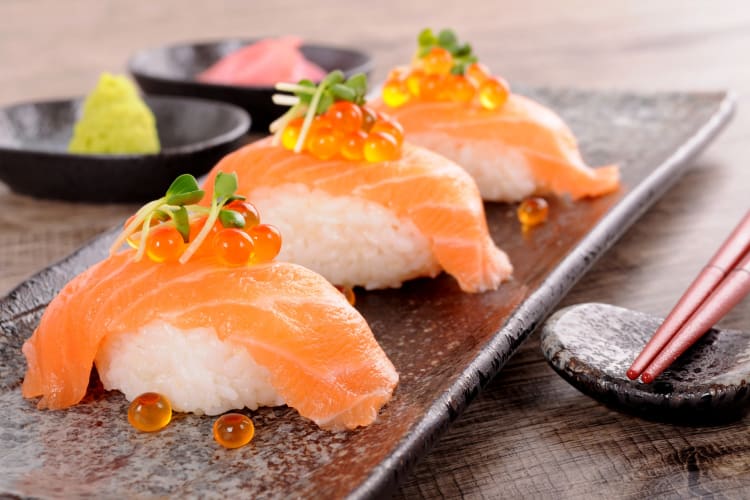
Rich in Heart-Healthy Omega-3s
Oily fish like salmon, tuna and mackerel are loaded with omega-3 fatty acids, which help reduce inflammation, support cardiovascular health and improve brain function. If you're still wondering: “Is sushi healthy?”, omega-3s alone make it a great choice for your heart and mind.
Helps With Muscle Repair and Recovery
The high-quality protein from ingredients like fish and tofu in sushi helps rebuild and repair muscles, making it an excellent post-workout meal. This protein also helps keep you energized and supports healthy skin, hair and nails, further showcasing why the answer to: “Is sushi healthy?” is often a confident yes.

Supports Digestive Health
Seaweed and vegetables like avocado and cucumber are packed with fiber, promoting healthy digestion. Sushi also often comes with ginger and wasabi, which are rich in antioxidants and can further benefit gut health. So, is sushi healthy for your digestion? Absolutely!
Helps Manage Weight
Sushi, when made with fresh ingredients and minimal sauces, is low in calories and packed with nutrients, making it ideal for those looking to maintain or manage their weight. Brown rice options add even more fiber to keep you feeling full longer, showing once again that sushi is healthy.
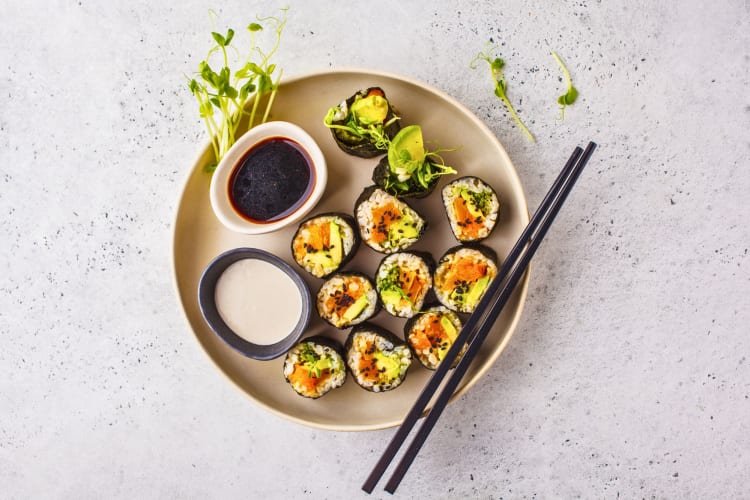
Delivers Essential Vitamins and Minerals
Fish and seaweed in sushi are rich in vitamin D, iodine, calcium and B vitamins, which are vital for bone health, thyroid function and energy production. These essential nutrients highlight why the question: “Is sushi healthy?” is often answered with a resounding yes, making the food an excellent addition to a balanced diet.
What Is the Healthiest Sushi?
Now that we’ve explored the answer to: “Is sushi healthy?”, let’s dive into the healthiest options you can choose. Sushi can be a nourishing addition to your diet when you prioritize fresh vegetables, lean protein and whole grains like brown rice while skipping heavy sauces and fried components.
To help you narrow down which sushi options are the best to go for, we've rounded up a few of the healthiest and most popular types of sushi to consider.
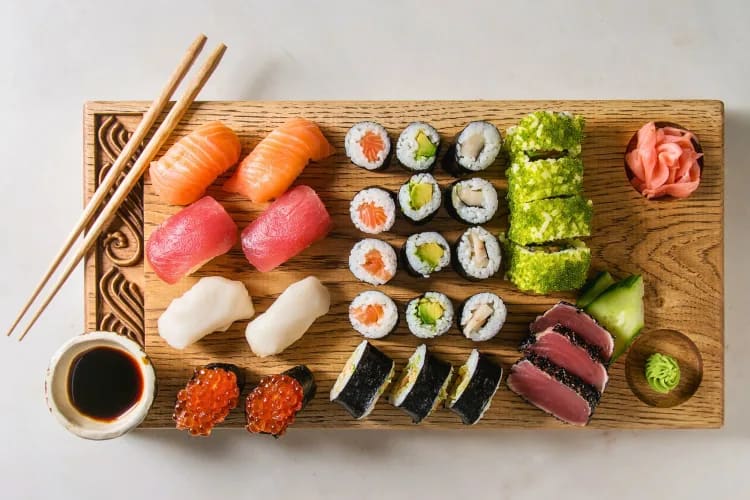
Tuna Roll With Masago
Opting for a tuna roll or tuna nigiri is a simple, protein-packed choice. But, is sushi healthy when tuna and masago are used together? Adding masago on top gives this sushi roll a flavorful boost along with an extra dose of omega-3 fatty acids and nutrients like vitamin B12. The clean ingredients and minimal preparation make this roll a healthier option while keeping things flavorful and satisfying.

Rainbow Roll
True to its name, the rainbow roll layers fresh slices of various fish. This usually includes ingredients such as tuna, salmon and snapper over a vegetable-filled base. The roll is high in lean protein and healthy fats while offering a mix of textures and nutrients.
For those wondering: “Is sushi healthy?”, the rainbow roll can be a nutritious choice. For an even healthier spin, ask for brown rice to add fiber and keep it nutrient-rich.
Salmon Avocado Roll
This classic roll brings together the omega-3-rich benefits of salmon and the heart-healthy fats and fiber of avocado. Together, they create a filling, nutrient-dense option that supports brain, heart and overall wellness.
This fish-infused type of avocado roll is typically simple and avoids the calorie overload of sauces or fried toppings, which makes the dish a win for anyone wondering: “Is sushi healthy?”
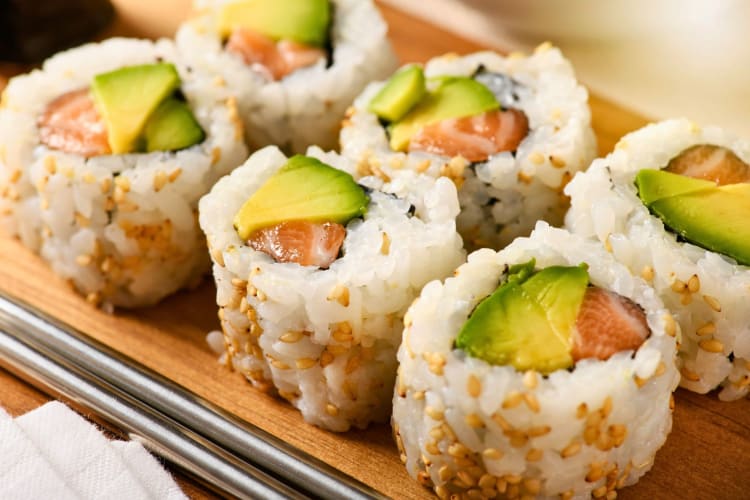
Vegetable Roll With Brown Rice
For plant-based eaters, or anyone looking to increase fiber intake, vegetable rolls are a fantastic choice. Ingredients like cucumber, avocado, carrots and oshinko are high in vitamins and minerals.
Opting for brown rice instead of white rice boosts the fiber content and provides more nutrients like magnesium and antioxidants. If you're debating if sushi is good for you, a vegetable roll with brown rice is a solid contender.
Homemade Sushi
Making sushi at home can also be an excellent option as you can control exactly what goes into each piece. If you’re inspired to incorporate sushi into your diet by preparing it yourself, consider exploring healthy online cooking classes or trying your hand at online sushi making classes. These experiences can help you make healthier, balanced sushi at home while perfecting your culinary skills.

What Is the Unhealthiest Sushi?
Sushi often carries a reputation for being light and nutritious. However, as we have previously discussed, the answer to: “Is sushi healthy?” depends heavily on the ingredients and preparation.
While many options showcase fresh fish and vegetables, others lean on calorie-heavy additions that can outweigh the benefits. These are the kinds of sushi you’ll want to enjoy in moderation. Let’s take a closer look at the unhealthiest picks and what makes them less than ideal.

Tempura Roll
If you’re wondering: “Is sushi healthy for you?”, tempura rolls are not the answer. Tempura involves battering and deep-frying seafood or vegetables, turning a potentially healthy ingredient into a calorie and saturated fat bomb.
The crispy texture might be tempting, but the frying process adds unhealthy fats and excess calories that can make this choice less than ideal. If healthy sushi is your aim, save these rolls for occasional indulgences.
Spicy Tuna Roll
For those asking: “Is sushi a healthy food?”, rolls like the spicy tuna roll can be a mixed bag. While tuna is a lean source of protein and omega-3s, the addition of spicy mayonnaise significantly increases the calorie and fat content.
This creamy topping often overshadows the roll’s healthier elements, like fresh fish and vegetables. To keep your sushi meal on the healthier side, opt for a simple tuna roll without the mayonnaise or ask for the spicy sauce on the side to better control portions.

Dragon Roll
Dragon rolls and similar specialty rolls often come drizzled with sweet or creamy sauces like eel sauce or teriyaki. While these sauces enhance flavor, they are usually high in sugar and sodium, which isn’t great for overall health. If you’re asking: “Is sushi healthy?”, be mindful of these toppings and consider asking for sauce on the side to better control your intake.
Philadelphia Roll
If you’ve ever asked: “Is sushi good for you?”, rolls like the Philadelphia roll are where things get tricky. While it contains salmon and avocado, which offer healthy fats and nutrients, the addition of cream cheese turns this into a calorie-heavy choice.
Cream cheese is packed with saturated fat and adds little nutritional value, making this roll less ideal for those looking to keep their sushi healthy. Enjoy it in moderation or swap it for a simpler roll without creamy additions if healthy sushi is what you are looking for.

Is sushi healthy? It’s no wonder this question comes up so often. Sushi is everywhere. Whether you’re picking up a quick roll at the grocery store, indulging at a high-end sushi bar or enjoying the fun of a conveyor belt spot, sushi’s universal appeal is undeniable.
So, is sushi healthy? Absolutely, if you choose wisely. With fresh fish, crisp vegetables and nutrient-rich options like brown rice, sushi can fit beautifully into a balanced diet. The answer to whether sushi is healthy or not lies in how you approach it, swapping heavy sauces and fried ingredients for lighter, wholesome alternatives.
For even more ways to explore your favorite foods, check out other experiences happening on Cozymeal.



FOOD FOR THOUGHT?
Join the conversation.